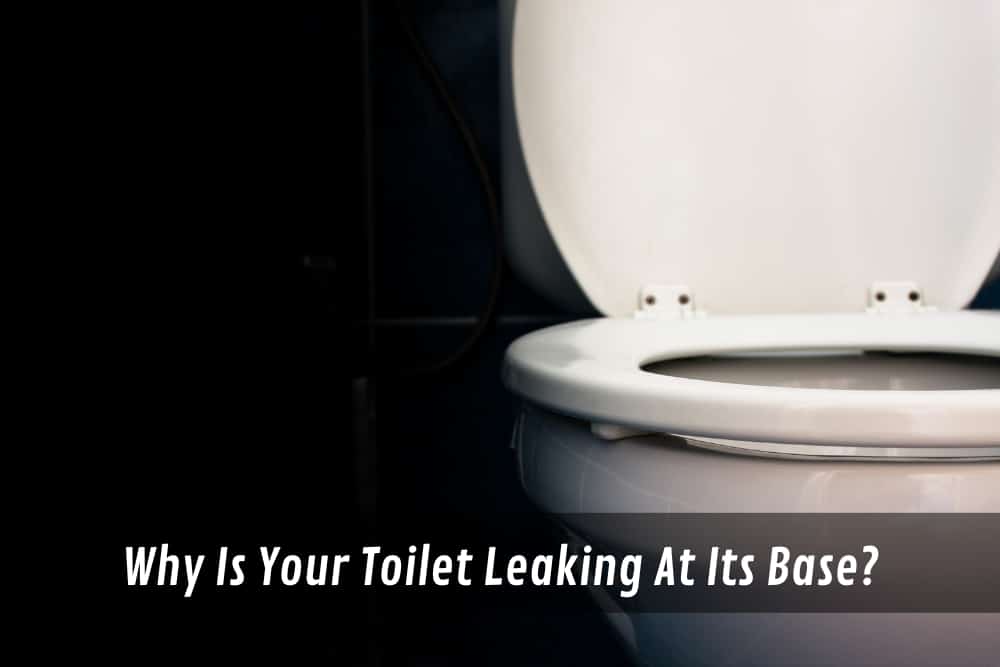Is your toilet leaking from the base? If so, you are not alone. A leaking toilet can be a frustrating and messy problem that can cause deterioration to your bathroom floor if not addressed promptly. In this blog post, we’ll explore the common causes of a toilet leaking from the base, how to diagnose the issue, and what steps you can take to fix the problem. So, if you’re tired of dealing with a leaky toilet, keep reading to learn more.
What are the signs and potential causes of a toilet leaking from its base?
If you notice a toilet leaking from its base after flushing, there are several signs and potential causes to consider. Here are some key points to help you understand the issue:
Signs of a toilet leaking from its base:
- Water pooling around the base of the toilet.
- Dampness or water stains on the floor near the toilet.
- Gradually increasing water damage to the flooring or subfloor.
- A persistent foul odour is caused by water leakage.
Potential causes of a toilet leaking from its base:
- Worn-out wax ring: The wax ring located between the toilet base and the flange can degrade over time. This can cause water to seep through the gap and leak onto the floor.
- Loose toilet bolts: If the bolts securing the toilet to the floor become loose, they can create gaps that allow water to escape during the flushing process.
- Cracked toilet base: A crack in the toilet base can lead to leaks. These cracks can develop due to physical damage or aging of the porcelain material.
- Improper sealing: If the toilet was not installed perfectly or the sealing material used during installation has deteriorated, it can result in water leaking from the base.
What are the possible risks and damages associated with a leaking toilet?
Left unaddressed, a leaking toilet can cause severe and costly damage to your home. Water that seeps through the floor or collects around the base of the toilet could damage your flooring, walls, and ceiling. This could lead to mould growth, which is dangerous and expensive to remove. Even if you think the leak is small, it’s important to have it addressed as soon as possible.
Not only do you risk potential property damage by ignoring a leaking toilet. But you can be stuck with an even bigger repair bill in the long run. Ignoring a minor issue could lead to more serious problems such as cracked pipes or corroded fittings. These kinds of repairs will be much more costly than simply addressing the problem early.
In addition to potential property damage, a leaking toilet can increase your water bill if the leak is coming from the supply line. The best way to avoid costly repairs and increased water bills is to address any issues with your toilet as soon as you notice them.
What are some do-it-yourself solutions for repairing a toilet leak at the base?
If you’re looking to repair a toilet leak at the base yourself, there are a few do-it-yourself solutions you can try. Keep in mind that these suggestions are general and may not apply to all situations. Here are some steps to follow:
- Identify the problem: Determine the source of the leak by inspecting the toilet base and surrounding area. Look for cracks, gaps, or signs of wear in the wax seal.
- Turn off the water supply: Before starting any repairs, turn off the water supply to the toilet. Locate the shut-off valve, usually located on the wall near the toilet base, and turn it clockwise to close it. Flush the toilet and hold down the handle to drain as much water as possible from the tank and bowl.
- Remove the toilet: Use a putty knife or a similar tool to scrape away the wax seal around the base of the toilet. Unscrew the nuts from the bolts securing the toilet to the floor. Carefully lift the toilet straight up and remove it. Place the toilet on an old towel or newspaper to prevent any water or debris from spreading.
- Inspect and replace the wax seal: Examine the wax seal located on the flange and toilet outlet. If it appears worn, damaged, or flattened, it should be replaced. Gently scrape away any remaining wax residue using the putty knife. Install a new wax seal by carefully aligning it with the toilet outlet and pressing it into place.
- Reinstall the toilet: Lower the toilet back onto the flange, ensuring that the bolts pass through the corresponding holes. Press down firmly to create a good seal with the new wax ring. Evenly tighten the nuts onto the bolts, but be careful not to overtighten and crack the toilet. Remove any excess wax that may have squeezed out.
- Turn on the water supply: Open the shut-off valve by turning it counterclockwise to restore the water supply to the toilet. Allow the tank to fill up, and then flush the toilet. Monitor the base for any signs of leakage. If there are no leaks, the repair should be successful.
- Clean up and test: Wipe away any excess wax or debris from the base of the toilet and the floor. Check for any water seepage or leaks over the next few hours or days to ensure the problem has been fully resolved.
Remember, these DIY solutions may not work in every situation. It’s important to assess your comfort level and skill set before attempting any repairs. If you’re unsure or if the problem persists, it’s recommended to seek professional assistance from a reliable toilet repair service.
At what point should one consider seeking the services of a licenced plumber?
If you’ve attempted do-it-yourself repairs and your toilet is still leaking at its base, it may be time to call an experienced plumber. A licenced plumber can quickly diagnose and fix any issue with your toilet. They may also be able to identify underlying problems that could lead to further damage or costly repairs if left unaddressed.
In addition to potential property damage, a leaking toilet can increase your water bill if the leak is coming from the supply line. If this is the case, an experienced plumber will be able to assess the situation and determine where the leak is originating from more quickly than you would be able to on your own.
Furthermore, a plumber can evaluate the condition of the piping and make sure that everything is up to code. This can help avoid any potential legal issues down the road.
In summary, if your toilet is leaking at its base, you may need to replace the wax ring or tighten the bolts attaching it to the floor. If your attempts at do-it-yourself repairs are unsuccessful, it’s best to call a licensed plumber as soon as possible in order to avoid further damage and costly repairs later on.
What are the recommended prevention methods to avoid potential leaks in the future?
- One of the best ways to prevent leaks from occurring in the future is by regularly inspecting your toilet. Look for any signs of wear and tear, such as cracks or weak spots in the bowl, tank, or base. You should also check the water supply line for any potential clogs, kinks, or other blockages that may be causing issues. Additionally, make sure to keep a close eye on the water level in the bowl. Use a plunger if needed to clear any blockages.
- Another way to help avoid leaks is by tightening all toilet bolts and connections on your toilet regularly. Improperly secured bolts may result in leakage from the joint between the toilet bowl and the floor. This can lead to moisture damage under your floor, so it’s important to tighten them every few months.
- Finally, if you notice any leaks from your toilet tank or bowl, call a professional plumber as soon as possible to get it fixed before it causes further damage.
Conclusion
To sum up, one of the common toilet problems you should fix immediately is a leaking toilet at its base. This issue can be caused by various factors. So, it is essential to inspect the toilet regularly and tighten all connections on the toilet bowl, including the bolts. Seeking professional help is necessary if there is a leak or a blocked toilet, which can quickly turn into a plumbing emergency. If a toilet problem persists, removing the toilet may be necessary to diagnose and fix the issue to prevent further damage.
Here at Plumbing Services Sydney, we understand the importance of addressing toilet problems immediately, and will do our best to have your toilet running smoothly again in no time! Contact us today to learn more about how we can help you with your leaking toilet problem.




